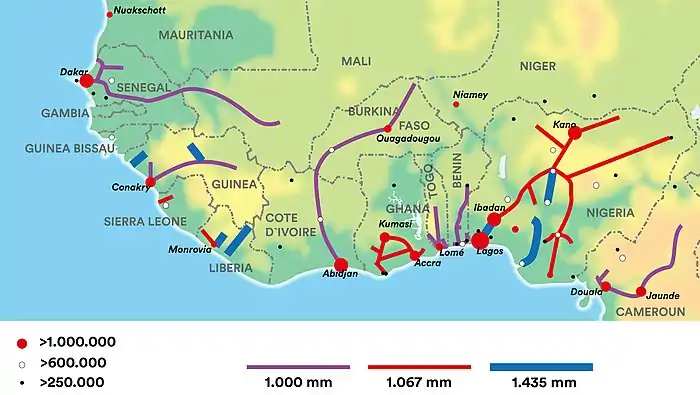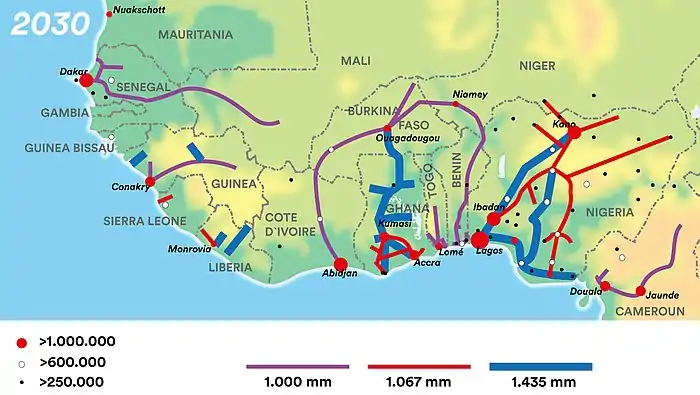ECOWAS rail
One of the goals of the Economic Community of West African States (ECOWAS) is the development of an integrated railroad network.
Aims include the extension of railways in member countries, the interconnection of previously isolated railways and the standardisation of gauge, brakes, couplings, and other parameters.
Proposed lines
The first line would connect the cities and ports of Lagos, Cotonou, Lomé and Accra and would allow the largest container ships to focus on a smaller number of large ports, while efficiently serving a larger hinterland. This line connects 3 ft 6 in (1,067 mm) gauge and 1,000 mm (3 ft 3+3⁄8 in) metre gauge systems, which would require four rail dual gauge, which can also provide standard gauge.[1]

Railways in West Africa, 2022

Possible situation in 2030
Gauge (railway)
| System | Gauge | Remarks |
|---|---|---|
| 1,000 mm (3 ft 3+3⁄8 in) | ||
| 1,000 mm (3 ft 3+3⁄8 in) | ||
| 1,000 mm (3 ft 3+3⁄8 in) | ||
| 1,067 mm (3 ft 6 in) | conversion to 1,435 mm (4 ft 8+1⁄2 in) starts 2019. | |
| 1,435 mm (4 ft 8+1⁄2 in); 1,067 mm (3 ft 6 in) | ||
| 1,000 mm (3 ft 3+3⁄8 in) | ||
| 1,067 mm (3 ft 6 in); 1,435 mm (4 ft 8+1⁄2 in) | conversion to SG starts 2018. | |
| 1,000 mm (3 ft 3+3⁄8 in) | ||
| 1,000 mm (3 ft 3+3⁄8 in) | ||
| 1,067 mm (3 ft 6 in) | ||
| 1,000 mm (3 ft 3+3⁄8 in) | (suspended) | |
| 1,000 mm (3 ft 3+3⁄8 in); 1,435 mm (4 ft 8+1⁄2 in) |
Standards
- Brakes: Air brakes
- Electrification: 25 kV AC
- Couplings: vary
See also
References
- "PROPOSED ECOWAS RAILWAY | Railways Africa". www.railwaysafrica.com. Archived from the original on 2009-10-24.
This article is issued from Wikipedia. The text is licensed under Creative Commons - Attribution - Sharealike. Additional terms may apply for the media files.